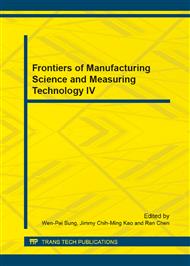p.169
p.179
p.183
p.187
p.191
p.196
p.201
p.207
p.212
Double Sided Explosive Cladding of Stainless Steel and Regular Steel
Abstract:
In order to ensure the quality of charge, honeycomb structure explosives was designed to resolve the current issue about the backward method of charge; Explosives with structure of honeycomb and double sided explosive cladding are used to increase of energy efficiency of explosives and save the amount of explosives. In this paper, the experiment of double sided explosive cladding for stainless steel and regular steel was successful investigated. Compared to the existing explosive cladding method, the consumption of explosives for stainless steel to steel of Q235 are reduced by 77% in the case of cladding the same number of composite plates.The explosive cladding parameters were calculated before experiment. It has shown that the calculated parameters prefigure exactly the explosive cladding windows for stainless steel/regular steel.
Info:
Periodical:
Pages:
191-195
Citation:
Online since:
August 2014
Authors:
Price:
Сopyright:
© 2014 Trans Tech Publications Ltd. All Rights Reserved
Share:
Citation:


